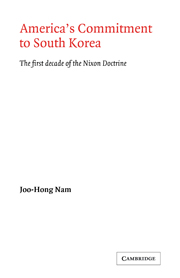Book contents
- Frontmatter
- Contents
- Preface
- Introduction
- PART ONE GENESIS
- PART TWO STRATEGY AND DOCTRINE
- 2 UNLIMITED CONTAINMENT
- 3 THE STRATEGIC IMPLICATIONS FOR KOREA OF THE NIXON DOCTRINE
- 4 THE BALANCE-OF-POWER IMPLICATIONS FOR KOREA OF THE NIXON DOCTRINE
- 5 NIXON'S LEGACY: CARTER'S POLICY OF TROOP WITHDRAWAL FROM KOREA
- 6 CONCLUSION
- Appendix I Outline of U.S. military deployment in the Western Pacific region
- Appendix II Military strength on the Korean peninsula
- Notes
- Index
3 - THE STRATEGIC IMPLICATIONS FOR KOREA OF THE NIXON DOCTRINE
Published online by Cambridge University Press: 07 October 2011
- Frontmatter
- Contents
- Preface
- Introduction
- PART ONE GENESIS
- PART TWO STRATEGY AND DOCTRINE
- 2 UNLIMITED CONTAINMENT
- 3 THE STRATEGIC IMPLICATIONS FOR KOREA OF THE NIXON DOCTRINE
- 4 THE BALANCE-OF-POWER IMPLICATIONS FOR KOREA OF THE NIXON DOCTRINE
- 5 NIXON'S LEGACY: CARTER'S POLICY OF TROOP WITHDRAWAL FROM KOREA
- 6 CONCLUSION
- Appendix I Outline of U.S. military deployment in the Western Pacific region
- Appendix II Military strength on the Korean peninsula
- Notes
- Index
Summary
THE EVOLVING ROLE OF US FORGES IN KOREA
(i) US forces as a deterrent
The American experience in Vietnam demonstrated that the use of extensive military power could not guarantee desired outcomes, and that America should exercise its military commitment abroad with restraint. Americans now thought that imperial interventionism had after all led the US ‘mistakenly’ into Indochina. With the erosion of the impulse to maintain an imperial domain, there was a much lessened fear of a loss of American influence in the Asian periphery. It even appeared that the maintenance of existing US commitments to allies in East Asia would no longer in itself entail an automatic US military involvement in local conflicts. Indeed, there was an almost emotional response among the American public at large against any foreign military intervention (e.g. the War Powers Act of 1973). This feeling eventually led to the collapse, if temporarily, of American interest in Southeast Asia during the period 1975–8. In addition, the Watergate scandals brought about the end of clear-cut presidential direction of foreign policy in the face of a more assertive Congress. Consequently, the decision-making process became even more diffuse and fragmented.
It was under these overall circumstances that the US government began to give serious consideration to shifting its global posture from a strategy of ‘two and a half wars’ to that of ‘one and a half wars’.
- Type
- Chapter
- Information
- America's Commitment to South KoreaThe First Decade of the Nixon Doctrine, pp. 74 - 108Publisher: Cambridge University PressPrint publication year: 1986

